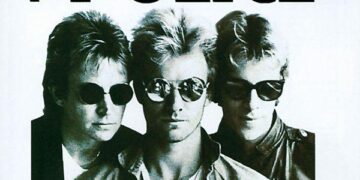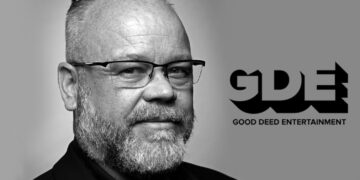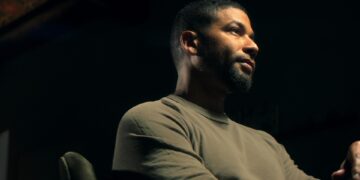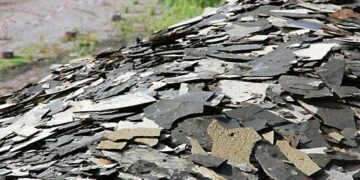The recipient of the 2024 Crafoord Prize in Mathematics discusses math as art, math as language, and math as abstract thought.

Laurence Geai for Quanta Magazine
Introduction
It took a long time for Claire Voisin to fall in love with mathematics.
That’s not to say she ever disliked the subject. Growing up in France — the 10th of 12 children — she enjoyed spending hours solving math problems with her father, an engineer. By the time she turned 12, she had begun reading a high school algebra textbook on her own, fascinated by the definitions and proofs outlined in its pages. “There was all this structure,” she said. “Algebra is really a theory of structures.”
But she didn’t see math as a lifelong calling. It wasn’t until her university years that she recognized how deep and beautiful it could be — and that she was capable of making new discoveries. Until then, she seriously pursued several interests besides math: philosophy, painting and poetry. (“When I was 20, I think I did only mathematics and painting. That was maybe a bit excessive,” she laughed.) By her early 20s, mathematics had subsumed everything else. But painting and poetry continued to influence her. She sees math as an art — and as a way to push at and play with the very limits of language.
Decades later, after becoming a leader in the field of algebraic geometry, Voisin has again found time to paint and make clay sculptures. Still, mathematics continues to occupy most of her attention; she prefers to spend her time exploring this “different world” where “it’s like you are dreaming.”
Voisin is a senior researcher at the French National Center for Scientific Research in Paris. There, she studies algebraic varieties, which can be thought of as shapes defined by sets of polynomial equations, the way a circle is defined by the polynomial x2 + y2=1. She is one of the world’s foremost experts in Hodge theory, a toolkit that mathematicians use to study key properties of algebraic varieties.
Voisin has won a litany of awards for her work, including the Clay Research Award in 2008, the Heinz Hopf Prize in 2015, and the Shaw Prize for mathematics in 2017. In January, she became the first woman to be awarded the Crafoord Prize in Mathematics.
Quanta spoke with Voisin about the creative nature of mathematics. The interview has been condensed and edited for clarity.

Voisin emphasizes the importance of language in mathematics for understanding old concepts, and for creating new ones. “You could compare a mathematical theorem to a poem,” she said.
Laurence Geai for Quanta Magazine
Introduction
You enjoyed math as a child, but didn’t see yourself pursuing it. Why not?
There’s the magic of a proof — the emotion you feel when you understand it, when you realize how strong it is and how strong it makes you. As a child, I could already see this. And I enjoyed the concentration that mathematics requires. It’s something that, getting older, I find more and more central to the practice of mathematics. The rest of the world disappears. Your whole brain exists to study a problem. It’s an extraordinary experience, one that’s very important to me — to make yourself leave the world of practical things, to inhabit a different world. Maybe this is why my son enjoys playing video games so much.
But what made me a latecomer to mathematics, in some sense, is that I am absolutely not interested in games. It’s not for me. And in high school, mathematics felt like a game. It was hard for me to take it seriously. I didn’t see the depths of mathematics at first. Even when I started to discover very interesting proofs and theorems after high school, at no point did I think that I could invent something myself, that I could make it mine.
I had a need for something deeper, more serious, something that I could make mine.
Before you found that in math, where did you look for it?
I enjoyed philosophy and its insistence on the notion of a concept. Also, until I was around 22, I spent a lot of time painting, especially figurative pieces inspired by geometry. And I was very fond of poetry — of the work of Mallarmé, Baudelaire, René Char. I was already living in a sort of different world. But that’s normal, I think, when you are younger.
But mathematics became more and more important. It really takes all of your brain. When you are not at your desk working on a specific problem, your mind is still busy. So the more I did mathematics, the less I painted. I only recently started painting again, now that my children have all left the house and I have much more time.
What made you decide to devote most of your creative energy to math in the end?
Mathematics became more and more interesting to me. As a master’s and Ph.D. student, I discovered that the mathematics of the 20th century was something very deep and extraordinary. It was a world of ideas and concepts. In algebraic geometry, there was the famous revolution led by Alexander Grothendieck. Even before Grothendieck, there were incredible results. So it’s a recent field, with ideas that are beautiful but also extremely powerful. Hodge theory, which I study, was part of that.
It became more and more clear that my life was there. Of course, I had a family life — a husband and five children — and other duties and activities. But I realized that with mathematics, I could create something. I could devote my life to it, because it was so beautiful, so spectacular, so interesting.

Claire Voisin considers herself a “latecomer” in falling in love with mathematics. She is now one of the world’s foremost experts in the field of algebraic geometry.
Laurence Geai for Quanta Magazine
Introduction
You’ve written before about how math is a creative endeavor.
I am a professional mathematician, so my working day is officially organized around mathematics. I sit at a desk; I work on a computer. But most of my math activity does not happen during that time. You need a new idea, a good definition, a statement that you think you’ll be able to exploit. Only then can your work start. And that does not happen when I am at my desk. I need to follow my mind, to keep myself thinking.
It sounds like math is deeply personal for you. Have you discovered anything about yourself in the process?
Doing mathematics, most of the time I have to sort of fight against myself, because I am very disordered, I’m not very disciplined, and I also tend to get depressed. I don’t find it to be easy. But what I discovered is that at some moments — like in the morning over breakfast, or when I am walking through the streets of Paris or doing something mindless like cleaning — my brain starts working by itself. I realize that I am thinking about mathematics, without having intended to. It’s like you are dreaming. I am 62, and I have no real method for doing good mathematics: I still more or less wait for the moment when I get some inspiration.
You work with very abstract objects — with high-dimensional spaces, with structures that satisfy complicated equations. How do you think about such an abstract world?
It’s not that hard, actually. The most abstract definition, once you are familiar with it, is not abstract anymore. It’s like a beautiful mountain that you see very well, because the air is very clear and there is light that lets you see all the details. To us, the mathematical objects we study look concrete, because we know them much better than anything else.
Of course, there are plenty of things to prove, and when you start learning something, you may suffer because of the abstraction. But when you use a theory — because you understand the theorems — you in fact feel very close to the objects in question, even if they are abstract. By learning about the objects, by manipulating them and using them in mathematical arguments, they ultimately become your friend.

For Voisin, mathematics is deeply personal. “There’s the magic of a proof — the emotion you feel when you understand it, when you realize how strong it is and how strong it makes you.”
Laurence Geai for Quanta Magazine
Introduction
And this also requires seeing them from different viewpoints?
I didn’t study algebraic geometry originally. I worked in complex analytic and differential geometry. In analytic geometry, you study a much larger class of functions and the shapes that are locally defined by those functions. They don’t usually have a global equation, unlike in algebraic geometry.
I didn’t pay too much attention to the algebraic viewpoint at first. But the older I get and the more I work in this area, the more I see the necessity of having these two different languages.
There’s an incredible theorem, called GAGA, which is a bit of a joke; it means “senile” in French, but it also stands for géometrie algébrique et géométrie analytique. It says that you can pass from one language to the other. You can make a computation in complex analytic geometry if it is easier, then come back to algebraic geometry.
Other times, algebraic geometry gives you the possibility of studying a different version of a problem that can give extraordinary results. I’ve worked toward understanding algebraic geometry as a whole, rather than just focusing on the complex-geometry side of it.
It’s interesting that you think of these as different mathematical languages.
Language is essential. Before mathematics, there is language. A lot of logic is already inside language. We have all these logical rules in mathematics: quantifiers, negations, parentheses to indicate the right order of operations. But it is important to realize that all these rules that are vital for mathematicians are already in our everyday language.
You could compare a mathematical theorem to a poem. It is written in words. It’s a product of language. We only have our mathematical objects because we use language, because we use everyday words and give them a specific meaning. So you can compare poetry and mathematics, in that they both completely rely on the language but still create something new.

Voisin sometimes relaxes by painting both original works (shown behind her) and copies of famous portraits, like the Amedeo Modigliani at bottom left.
Laurence Geai for Quanta Magazine
Introduction
You were drawn to math because of Grothendieck’s revolution in algebraic geometry. He essentially created a new language for doing this kind of mathematics.
Right.
Are there ways in which the mathematical language you’re using now might still need to change?
Mathematicians constantly rework their language. It’s a pity, because it makes older papers quite hard to read. But we rework past mathematics because we understand it better. It gives us a better way of writing and proving theorems. This was the case with Grothendieck, with his application of sheaf cohomology to geometry. It is really spectacular.
It’s important to become familiar with the object you study, to the point that for you it’s like a native language. When a theory is beginning to form, it takes time to figure out the right definitions, and to simplify everything. Or maybe it is still very complicated, but we become much more familiar with the definitions and objects; it becomes more natural to use them.
It’s a continuous evolution. We constantly have to rewrite and simplify, to theorize about what is important, about what tools to make available.

Voisin is drawn to the concentration that mathematics requires. When doing mathematics, she said, “the rest of the world disappears.”
Laurence Geai for Quanta Magazine
Introduction
Have you had to introduce new definitions in your work?
Sometimes. In work I did with János Kollár, there was a turning point where we were finally able to find the right view of the problem — through a certain definition. This was a very classical problem, and we worked with classical tools, but our proof was really based on this definition that we set up.
In another case, Olivier Debarre, Daniel Huybrechts, Emanuele Macrì and I proved a nice classification result about objects called hyper-Kähler manifolds. And the starting point for that proof was the introduction of an invariant, which we very originally called “a.” [Laughs.]
You might underestimate the importance of definitions in mathematics, but you shouldn’t.
Definitions and language aren’t the only guiding forces in mathematics. So are conjectures, which might or might not be true. For instance, you’ve done a lot of work on the Hodge conjecture, a Clay millennium problem whose solution comes with a $1 million reward.
Say you have an algebraic variety you want to understand. So you go to the complex-analytic geometry side and consider it instead as what’s known as a complex manifold. You can think of a complex manifold in terms of its global shape, or topology. There is an object, called a homology, which gives you a lot of topological information about the manifold. But it is not so easy to define.
Now consider algebraic subvarieties inside your original variety. Each will have a topological invariant, certain topological information associated to it. Which part of the complex manifold’s homology can be obtained by looking at these topological invariants?
The Hodge conjecture gives a specific answer. And the answer is very subtle.

Voisin finds that the most abstract mathematical object becomes concrete once she’s become familiar with it. “It’s like a beautiful mountain that you see very well, because the air is very clear and there is light that lets you see all the details.”
Laurence Geai for Quanta Magazine
Introduction
So mathematicians aren’t sure if the Hodge conjecture will end up being true or false?
You want to believe in the Hodge conjecture, because it is such a guide in major theories in algebraic geometry.
You’d really like to understand the main properties of an algebraic variety. And if the Hodge conjecture is true, that would give you incredible control of the geometry of your variety. You’d get very important information about the structure of varieties.
There are some strong reasons to believe in it. Particular cases of the Hodge conjecture are known. And there are many deep statements about algebraic varieties that hint that the Hodge conjecture is true.
But there’s been almost a complete lack of progress toward proving it. I also proved that there is no way to extend the Hodge conjecture to another setting where it would seem natural. So that was a bit of a shock.
After decades working as a mathematician, do you feel like you’re doing math even more deeply now?
Now that I am older, I have much more time to spend my energy on mathematics, to be really present in it. I also have a better ability to go here and there. In the past, perhaps because I had less time, I had less mobility — though being too mobile, just touching problems without sticking with them, is not good either. Now I am more experienced, and I can build my own picture.
You have a much better picture of what you don’t know, of open problems. You have a detailed view of your field and its borders. There have to be some good aspects of getting older. And there’s still so much to do.
Next article
Physicists Finally Find a Problem for Quantum Computers Alone
>>> Read full article>>>
Copyright for syndicated content belongs to the linked Source : Quanta Magazine – https://www.quantamagazine.org/a-mathematician-on-creativity-art-logic-and-language-20240313/































